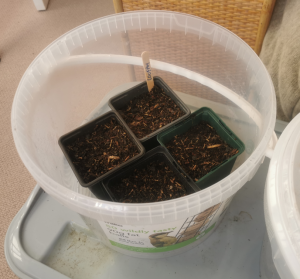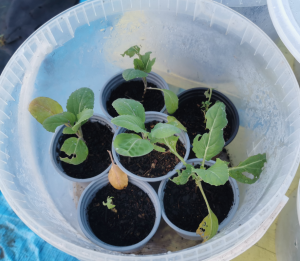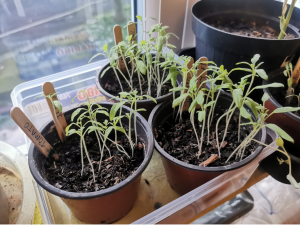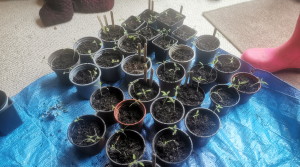
Introduction:
Welcome to our new blog series! This year, we are going to post monthly blogs with loads of information about what to sow during that month, indoors and out, or what you can directly sow outside, and also what you could be harvesting in that month.
If you are new to growing your own food and want to have a go, why not start this year? Email us for a free PDF guide to help you! Laura will also help via social media or email – laura.hamilton@tcv.org.uk
What You’ll Need:
- Seeds!
- Plant labels – I use wooden lollipop craft sticks from Poundland, but you can also cut up empty clean milk bottles into strips and use that,
- A marker pen to write on the labels,
- Peat free compost,
- Plant pots,
- A protective cover – greenhouse, polytunnel, plastic bags over pots, or folding plastic food trays (eat the pastry first!). You could also use a stackable clear plastic box,
- A drip tray if indoors – plate, bowl, drip tray, plastic fruit punnet (without holes), plastic bags also work
Choose Your Location:
A south facing room or window will be the hottest place in the house and get most direct sunlight, but any space will do. I have a mini plastic greenhouse in the garden which is north facing, but the greenhouse gets most of the sunlight each day. I also fully utilise every windowsill available.
I am also experimenting with using empty fat ball tubs as mini greenhouses – I have four or five pots in each one. This should keep the slugs off my calabrese!!
Seeds to Sow in February:
February brings with it a wider range of seeds to sow. If you didn’t do aubergine or tomato last month, you can do them this month – or sow more! If you have surplus plants in the summer you could give them away to friends, neighbours, or relatives. My allotment site has a community table where other plot holders can give away surplus plants – maybe set one up in your front garden or driveway?
This month, seeds you can sow indoors/under cover include:
- Pea – meteor, douce provence, early onward, and twinkle.
- Sprout – any variety
- Tomatoes, aubergine, leek, cauliflower, and cabbage – the same as January
- Broad bean – aquadulce Claudia
- Sweet bell pepper
- Artichoke
Flowers:
- Calendula (edible)
- Cornflower (edible)
- Sweet pea (non-edible – do not plant near or with your edible peas!!)
- Hollyhock

Cornflowers (blue) and calendula (orange) look great together, are fab for pollinators, and the petals can be sprinkled over salads! Image from: https://higgledygarden.com – click the picture to go to their page.
Herbs:
- Rosemary
- Chives
- Basil
- Parsley
- Lemon grass
- Oregano
Seeds to sow outdoors:
- Broad bean – aquadulce Claudia
This month, for something a bit special, I am also going to sow my loofah seeds. Yep – last year I tried to grow my own bath sponges and failed miserably, so I’m having another go this year. They need a long growing season so I have started them indoors now.
I do not have a greenhouse or heat mats, so I am limited with where I can grow. Work in a way that’s best for you – I simply don’t have room to start things all at the same time in March and April, so I spread things out month by month. I had sown seed outdoors at the end of Jan – winter hardy spring onion, early carrots, and early radish – but we then had 8cm of snow!
How to Do It:
Half fill the pot with peat free compost. Open the packet of seeds and sow them into the pot. A 10cm pot can take 10 seeds scattered on the surface of the compost – you will thin them out and pot them up later. This means you can have one pot of aubergine, one pot of tomato, one pot of cauliflower, one pot of leek, and one pot of cabbage.
Peas and sprouts will benefit from being sown in module seed trays, or you can do peas in toilet roll tubes. One sprout plant can produce around 40 sprouts, but make sure you sow enough seed to ensure plants survive to give you a harvest. Pigeons and slugs love sprouts. You could also start broad beans in module trays to give them more protection as they start growing.
If you use pots for peas, only do two or three to a pot to give them room to grow.
Remember to write and put a label in each pot! Gently cover the seeds over with more compost, water so they are damp but not soaked, and then pop each pot into wherever you are growing them (greenhouse, plastic box, windowsill etc). Indoor pots can be covered with a plastic bag/cling film to make individual greenhouses.
Keep an eye on the pots to make sure they don’t dry out, but don’t soak them either. In a warm place they should germinate after about a week. Be careful putting them above a radiator as this can dry the pots out too much.
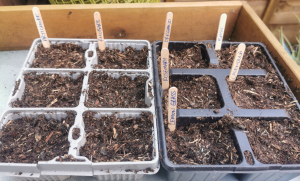
This months seeds – artichoke, rhubarb, herbs, calendula. I have also done loofah, tomatoes, hollyhock, and lobelia.
Harvesting Food in February:
There are some food crops ready to harvest in February if you have already started growing, or are returning to this article in 2022 and beyond (hello!). These are the same as January.
- Leek – giant winter – sow in late 2021 and harvest in 2022
- Kale – scarlet – pick the leaves off that you want to use and keep the rest on the plant to grow some more
- Sprouts – twist and pull the sprouts off, starting at the bottom of the stem. Pick them when they are around 3cm across.
- Swede – the leaves can be used in stir fry or bubble & squeak
Seeds Sown in January:
The seeds you sowed in January should be growing! My cauliflower started germinating only three days after sowing. This is what my pots of seeds look like now, one month later:
Potting Up Last Months Plants:
My seedlings are a month old and just starting to develop their true leaves. I will leave the cauliflower and aubergine as they are for now until they are bigger and stronger for handling and potting up. When the seedlings are about six weeks old they might be ready for potting up but you can leave them for another couple of weeks to get stronger.
My tomatoes and cabbage were starting to crowd their pots so I decided to pot them up. I now have two or three seedlings per pot, each with fresh peat free compost. I put them in a clip top box and they are now out in the garden lined with bubble wrap as I don’t have enough room indoors.
To do this, gently turn the pot upside down with one hand at the top. Tap the bottom to eject the seedlings and compost. You can use a flat knife or lollipop stick to separate the seedlings from each other. Half fill a pot with compost, poke a hole in, and place the roots of the seedlings into the hole. I did two per pot. Top up the compost and firm it around the plant, pinching with your fingers. I planted mine quite deeply – the tomatoes will put out extra roots from the stem. If you do this indoors like I did, make sure you put a protective surface down!
Next month we will be looking at sprouts, beans, cabbage, and early outdoor crops.
Remember to tag us and share pictures with us on social media – find us on:
And if you want help and advice, why not join our Grow Well, Eat Well group on Facebook? –
Don’t forget to claim your free guide via email, and happy growing!
